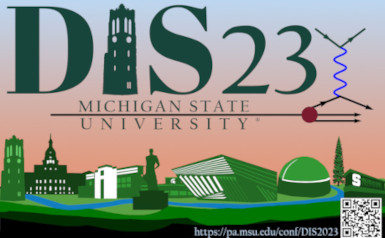Speakers
Description
Heavy quarkonium production of high transverse momentum ($p_T$) in hadronic collisions can be studied in the QCD factorization formalism in both leading and the first subleading power in $1/p_T$ expansion with heavy quarkonium fragmentation functions (FFs) [1]. The scale evolution of quarkonium FFs enables us to resum logarithmically enhanced corrections $\alpha_s\ln(p_T^2/m^2)$ with heavy quark mass $m$, which is an essential piece to explore the nonperturbative process of bound quarkonium formation. Boundary conditions of the evolution equations of the FFs at $p_T\sim 2m$ are given by combining perturbatively calculable coefficients in NRQCD and long-distance-matrix elements (LDMEs) for different intermediate states of a produced heavy quark pair. LDMEs correspond to relative weights of individual terms after expanding the input FFs in quark velocity $v$, and should be determined by data fitting.
We demonstrated in Ref.[1] that the QCD contribution to the production at the first subleading power is critically important for describing the full range of $p_T$-distributions of J/$\psi$ production at the hadron colliders, in particular, for the region of $p_T \ge {\cal O}(2m)$, while the leading power contribution describes the main feature of data for $p_T\gg {\cal O}(2m)$. In this talk, we will present our predictions for transverse momentum distribution of J$/\psi$ production in lepton-hadron scatterings at the EIC in terms of a hybrid factorization approach to take into account both collision-induced QCD and QED radiative corrections on equal footing [2]. At the EIC energy, we will demonstrate that the first subleading power contribution is very important for matching our calculations with the resummation of the logarithms to the fixed-order NRQCD calculations at $p_T\sim {\cal O}(2m)$. We will discuss the complementarity between inclusive high-$p_T$ J/$\psi$ production without measuring the scattered electron and the production of J/$\psi$ in semi-inclusive deep inelastic scattering (SIDIS) with the scattered electron measured. We will also discuss the transition from the collinear factorization regime to the phase-space where TMD factorization is necessary.
[1] K. Lee, J.W.Qiu, G. Sterman and K.Watanabe,
``Subleading power corrections to heavy quarkonium production in QCD factorization approach,'' [arXiv:2211.12648 [hep-ph]].
[2] T. Liu, W. Melnitchouk, J.W. Qiu and N. Sato,
``A new approach to semi-inclusive deep-inelastic scattering with QED and QCD factorization,'' JHEP 11, 157 (2021) [arXiv:2108.13371 [hep-ph]].
| Submitted on behalf of a Collaboration? | No |
|---|---|
| Participate in poster competition? | No |




